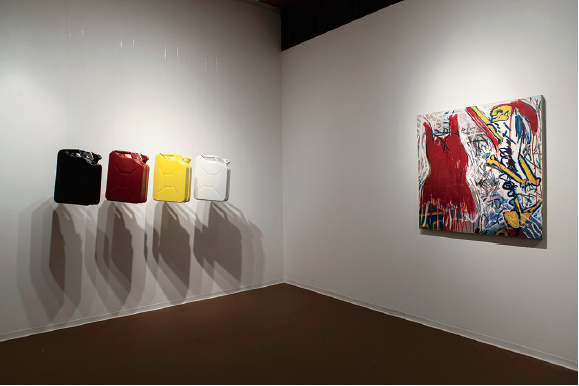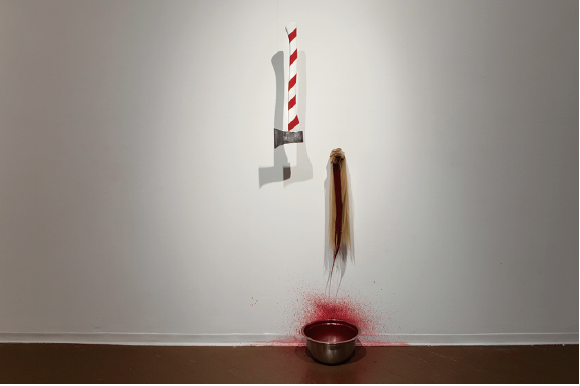Roger Crait
I walk into the Roger Crait show, “Home=Land Surveys (And Other Atrocities),” at Urban Shaman Gallery and I am momentarily surprised by what I see. Known for his large-scale panels and bold use of colour, Crait’s work bursts with dynamism, and Urban Shaman feels particularly alive—as though the walls are breathing. Adding to the intensity, this solo exhibition incorporates found sculpture as well as video, indicating new strategies in Crait’s trajectory.
The title of this exhibition, “Home=Land Surveys (And Other Atrocities),” gives the first hint of what I should expect. I sit with the words for a bit. Home, homeland, land, land surveys, atrocities. On its face, the title is another commentary on the effects of land dispossession and colonization. But there’s a subtext here, something playful and more literate than what first appears. Indeed, wordplay is an integral part of Crait’s work and adds a depth that engages the viewer in what feels like a puzzle of sorts.

Roger Crait, Man of the Cloth, 2017, four jerry cans, 14 x 16 x 61.5 inches each (left), and The Red Dress, 2017, oil on canvas, 42.5 x 42.5 inches (right). Images courtesy of Urban Shaman Gallery, Winnipeg.
The most obvious example of this is the found sculpture Barber. An axe handle is painted as a classic red and white barber pole and mounted alongside a scalp that runs with blood (a mixture of safflower oil and paint), gathered in a metal bowl below. An otherwise innocuous word—“Barber”—is imbued with history and trauma. The continuous flow reminds us that the blood has not yet stopped running.
Man of the Cloth is another found sculpture that seduces the viewer to delve more deeply into the puzzle. Four jerry cans are painted in medicine wheel colours and suspended 4 feet from the ground. Both bright and harsh, their shadows—intentional or not—add a depth that makes me want to understand. I connect the church to oil—our new god; I think of addiction and huffing—a direct result of Christianization; I wonder how a medicine wheel made of gasoline connects to my own experience.
In the centre of the gallery stand four white oil drums. Each oil drum has an accompanying large matchstick that, at this scale, resembles a traditional drumstick. This installation, Playing with Matches, combined with Man of the Cloth, creates a kind of dangerous ambiance in the space. It is not lost on the audience that it is explosive. During the opening, a group of drummers took to the installation; every 15 minutes or so the ominous, hollow beats interrupted the general audience’s comfort and conversation. They gained sentience with each rumble, and it was impossible to forget their relevance and presence here.

Roger Crait, The Barber, 2017, spray paint, found object, wig and pump.
What is clear in this exhibition is that Crait has spent his lifetime amalgamating his lived experience, formal training and inherent art practice into a language that communicates to a broad audience. While the wordplay and deeper metaphorical imagery appeal to those well-versed in the colonial history of Canada and an Indigenous experience, the visceral and tangible aspects of his use of colour and in-your-face storytelling also tap into a basic understanding that even a novice art-goer could appreciate. It is refreshing to be trusted by an artist. The work displays a confidence not only in its message, but also in its faith that the viewer will accept his invitation to enter his matrix of metaphor and imagery.
The work Canada’s Calendar of 150 Consolations: Cultural Genocide Through Legislation ensures that the connection to a larger context is also not completely overlooked. One hundred and fifty events of importance in Indigenous history in Canada and particularly Manitoba (i.e., from the signing of treaties, to Indian Act amendments, to monumental art installations) scroll on a looped video. Although less than four minutes in length, the persistent inundation of indisputable facts proves relentless, even for this viewer, who is familiar with the historical narrative. It is almost exhausting to maintain focus for the whole video, and it achieves a very specific objective: to wear you down with the weight of colonialism. Crait tells me the research for the piece was done by his partner, Valery Camarta, and took months of work and decision making about what to include. She uses the word intension to explain the work. It is an accurate description of my experience of the piece—both intentional and tense.

Roger Crait, installation view, “Home=Land Surveys (And Other Atrocities),” 2017, Urban Shaman Gallery, Winnipeg.
Crait is a Winnipegger through and through. A Cree kid raised in the south end, he was already receiving accolades in high school. He completed four years at the School of Art at the University of Manitoba, and has been presenting in solo and group exhibitions since 1997. The works I have described so far are indicative of his capacity to address larger, structural issues of colonialism, but he is more often associated with his skill at portraying a specific Winnipeg experience.
In more traditional Crait fashion— that is, large-scale painting and collage—the pieces Constitutional Rites, Not 4 Sale and Versus speak directly to Winnipeg history and landscape. Constitutional Rites (although inscribed on the canvas are remnants of another reading— “_cop_stitutional rites”) retells the shooting of Matthew Dumas with the most basic and relevant facts. A gunshot, a screwdriver and a dead young Native man occupy a large painting. A heartbreaking homage to a Métis boy, the piece has gained even more relevance in the wake of continued police violence in the last 15 years. I distinctly remember where I was the day I heard the news, and I am momentarily taken back in time. This is one example of the power of Crait’s work: to suspend the present, even if only for a moment, so that we can join in collective memory.
Not 4 Sale and Versus lay out the Winnipeg urban landscape— in particular, the Exchange and North Main—in a way that only a Winnipegger would completely understand. The cityscape— portrayed as half contemporary and Indigenous and half corporate—speaks to the gentrification that Crait has witnessed over the years. Between pawn shops and bars lie references to arts collectives and galleries. Corporate signage interjects and demonizes the streetscapes. But, to be clear, it doesn’t seem to be nostalgia driving these pieces—there is no regret in the changing of the landscape. Instead, it feels more like a tribute to a place that once was. Crait’s commentary on the city’s transformation isn’t dated or depressing. It acts more as an archive, with a glimpse of what eventually became.
I was sitting in his backyard when I asked Crait about his apparent absence from the art world for a number of years. He gestured to the beautiful gardens, greenhouses, deck and studio that adorn his North End home. He had to shift his focus for awhile to build this place, he said. He also works in construction, and the day I visited the gallery, he told me he had just put in a 76-hour workweek. Roger Crait is a builder. He likes to make things the best way he knows how. When pushed, he also admits that his absence was due to a disillusionment with the art world. For the artist who creates because they cannot not create, the business of art can become cumbersome and tedious.
This exhibition is an easy rewelcoming of Crait to a gallery. His past work has been described as “volatile” and as generating “an explosion of thick, resplendent colour.” Although not untrue, “Home=Land Surveys (And Other Atrocities)” reintroduces Crait being as much literary as he is visual. His practice of Indigenous orality—storytelling, place and subjectivity— is both visionary and sincere. I am almost inclined to argue that Crait is a wordsmith and storyteller before he is a visual artist. But his mastery of scale, landscape and sculpture demands he be recognized for all these crafts equally. Although not touring (as of yet), this show is a perfect entry point into Crait’s catalogue and is an exciting foreshadowing of work yet to come. ❚
“Home=Land Surveys (And Other Atrocities)” was exhibited at Urban Shaman Gallery, Winnipeg, from June 23 to July 29, 2017.
Tara Williamson is an Anishinaabe/ Nehayo (Ojibwe/Cree) writer, musician, academic and educator from Manitoba.

